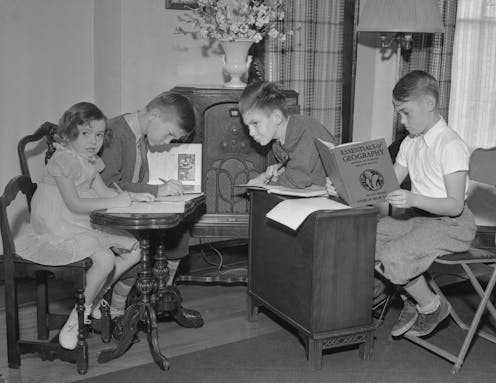Remote learning isn't new: Radio instruction in the 1937 polio epidemic
Curated from: theconversation.com
Ideas, facts & insights covering these topics:
4 ideas
·916 reads
5
Explore the World's Best Ideas
Join today and uncover 100+ curated journeys from 50+ topics. Unlock access to our mobile app with extensive features.
Education during epidemics
94% of countries implemented some form of remote learning during the pandemic. And this is not the first time that educators have made use of remote learning.
During a polio outbreak in 1937, the Chicago school system used radio to teach children. During other communicable illnesses, schools typically halted formal learning. Some kids played more while others went back to work at home or on family farms. School sometimes compensated for lost education by shifting the academic calendar or mandating Saturday attendance.
33
296 reads
Radio school
The radio school experiment during the polio outbreak was highly innovative and untested. Some 315,000 children in grades 3 through 8 received lessons on the radio while at home.
Chicago teachers collaborated to create on-air lessons for each grade, local radio stations donated air time, and local papers printed class schedules each morning. Classes were just 15 minutes, providing simple broad questions and assigning homework.
22
329 reads
Remote school challenges
News stories reporting on radio school were mostly positive, but articles also pointed out the challenges. Some children didn't have access to radios. Other kids were distracted or struggled to follow the lessons. They could not ask questions in the moment, and kids needed more parental involvement.
In 2020, when the pandemic shut down schools, many countries turned to multiple platforms, such as television, radio, and internet. However, they continue to face similar challenges to those the radio school faced in the 1930s.
25
141 reads
Lessons from remote education
The current pandemic has highlighted the burdens of the digital divide. Children in high-poverty communities don't have access to technology. It highlights the need for funding to address technological inequalities in schools.
Pandemic teaching could ultimately improve education. It could reshape education once school moves back to the classroom. Digital tools could enrich the curriculum and could create new ways to connect with students beyond the traditional modes of learning.
28
150 reads
IDEAS CURATED BY
Robert H.'s ideas are part of this journey:
Learn more about problemsolving with this collection
How to practice self-compassion
How to identify and challenge negative self-talk
How to build self-confidence
Related collections
Similar ideas
5 ideas
Can A Crisis Push Schools in a Positive Direction?
greatergood.berkeley.edu
3 ideas
Waldorf School Education
Sprouts
9 ideas
Read & Learn
20x Faster
without
deepstash
with
deepstash
with
deepstash
Personalized microlearning
—
100+ Learning Journeys
—
Access to 200,000+ ideas
—
Access to the mobile app
—
Unlimited idea saving
—
—
Unlimited history
—
—
Unlimited listening to ideas
—
—
Downloading & offline access
—
—
Supercharge your mind with one idea per day
Enter your email and spend 1 minute every day to learn something new.
I agree to receive email updates

